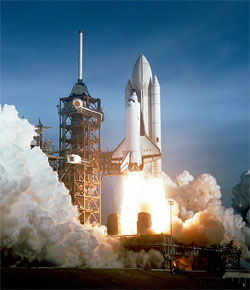
In the late 1970s the space shuttle programme at NASA was completed. NASA, an organisation that had seen much of its funding disappear in the post-lunar landing world, badly needed the shuttle, if not for the technical advantages it would bring (and they were supposed to be many), for the economic ones.
The idea of the space shuttle was fascinating to me as a child as it seemed as a step closer to ye olde sci-fi spaceships you’d encounter in books, movies and so on: they were partially reusable, albeit incapable of autonomous launch and re-launch, being dependent on massive launch rockets and fuel tanks. They had considerably larger space than the earlier capsules they replaced, allowing more comfortable (= lengthier) stay and additional scientific equipment.
Yet years of diminishing funds and a series of problems, including the losses of Challenger in 1986 and Columbia in early 2003, doomed the shuttle programme. But what’s there to replace it? What is NASA planning beyond 2010 and their series of unmanned satellites and explorer vehicles?
Shock-horror: an updated apollo-type rocket+capsule, called Orion, according to the BBC! While NASA claims that “giant leaps have since been made in computer technology, electronics, life support, propulsion and heat protection systems.” in relation to the system’s similarity to Apollo-era technology, I can’t but feel that it is an anachronistic move, perhaps token of NASA’s inability to further develop manned space technology under the current funding regime, itself a part of the diminishing importance of space exploration in the post cold-war era.
Now, how do you spell ‘Enterprise NCC-1701’ in Chinese?
